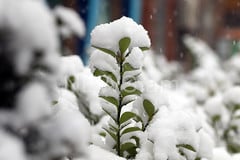
Armenian News-NEWS.am continues Arianne & Armenia project within the framework of which Arianne Caoili tells about numerous trips across Armenia and shares her impressions and experience of living in Armenia.
Next year, in Ararat
Topping the charts in 1951, Rosemary Clooney's biggest hit, Come on-a My House, was innocently penned one fine American day by cousins Ross Bagdasarian (creator of Alvin and the Chipmunks) and immortal author William Saroyan. Melodically derived from an Armenian folk song, it is a call for companionship to be held at the most sacred of places - the home, abundantly littered with cakes, candy, apricots, and of course, pomegranates.
Winter has arrived and New Year is upon us. The leaves have turned a darker shade of red in their daily transition to dried up brown. Ararat seems more imposing. Sewn into the neck of the earth like a majestic head, it sits impregnably on an ancient throne, on a land from which nations have originated, and to which people flow unto to worship. Its imperceptible, snow-capped crown casts an inescapable shadow all the way from crossing Haghtanakbridgeto the shores of Sevan to the grassy valleys of Shirak and across the balding spots of Ashtarak. It looms exalted over the city as a reminder of what once was and what could be.
When talking to most Armenians around town, the period around New Year appears to be a time of congregational whining: it is darker, more depressing, everything is permanently cold, they see the same left-over pig for seven days, their credit has stretched beyond the capacity of their future cash flow and faces on the street constrict. The cold oppresses sincerity to no more thanhurried half-smilesand the anxiousness of turning the gas on and off ticks nervously in the back of people's brains.
The invitation to Come on-a My House for the New Year appears to be an awkward burden borne by all parties, whether it is a ritualistic mourning or celebration or the usual merry-go-round that is the Armenian New Year (homes where death has brought the inevitable or where new life has breathed its first will be visited as a priority). The ride begins at around ten and finishes in the wee hours. After the first hour of the incoming new year, prepare for just about anyone to drop in.
In Australia, our yearly restitution is reflected in Christmas Day and the 'gift list': who (necessarily) to buy for and what to buy - questions rashly answered in a commercial blizzard the week before December 25 (having all forgotten that "it is more blessed to give than to receive" for the last 350 days of the year). All of this lust and hasty lashing out culminates into a miserly few minutes of an excitable gift unwrapping ceremony and a day of communal gluttony (all to be paid for by a big chunk of next year's pay checks).
In the final week of the year that was, Armenian uncles, fathers, and grandpas get ready for the big occasion by delivering the carefully calculated grocery list; and on the final day of the year, the women of the house arise in the early morning to prepare for what is to be a very long and expensive day (a day which brings either repressed or expressed regret, but regret nonetheless - even if its answer is ultimately found in the excitement of the discovery of resolutions which will serve as regret for next year's final day). Guests swarm in and linger, and pasus dolma and blinchiki pile up on table tops all around Armenia like casino chips on the successful side of a roulette table.
Persian philosopher and one of the world's very first self-diagnosed, proud alcoholics, Omar Khayyam, half-rightly concluded that
Now the New Year reviving old
desires
The thoughtful soul to solitude
retires.
I can't agree with the second part of Omar's depiction. In Armenia, the start of the New Year hardly brings any solitude. After (and before, and during) all that eating, are all of the communal toasts to usher in a year that is hopefully equal to or greater than the previous year. Alcohol is poured and shared in larger, more convoluted mixtures than all of the concoctions invented and meticulously listed in VenediktErofeev'sMoscow -Petushki. On the first day of the bright and shiny new year, your stomach declares war on your liver, being fully injected with an indeterminable soup of various sources - a stew that your sewerage has never known, but in or around the late afternoon of January 1, will surely greet.
The accompanying salutes of drinking vary in emotional potency, length, and sincerity, but nonetheless the kenats is the central point of the Armenian New Year: define your entrance into the host's house as your signature on the dotted line, and your participation in a toast as the fulfilment of your contractual obligation.
'Next Year in Jerusalem' (or rather, 'Next year in the rebuilt Jerusalem', for Jews living in Israel), is the cardinal toast that traditionally concludes the Passover Seder (the Jewish ritual symbolising the Israelite's miraculous exodus from their Egyptian overlords). As summarised by Rabbi David Hartman, "the cup of hope is poured every year. Passover is the night for reckless dreams; for visions about what a human being can be, what society can be, what people can be, what history may become".
Is Ararat the Armenian Jerusalem? I think the answer, even if restricted to a symbolical one, is yes. Although it is not a physically acquirable asset, lying enticingly close across a closed border, it serves as a constant reminder of disrespect at its most destructive and inhumane, while also motivating generations to create more from what they have been given. Its sheer presence alone - its omnipresent and dominating presence, inescapable from any window pane, city square, bridge, road or solitude street corner in Armenia, is so much more than what Frank Westerman termed the "mythical mountain" in his otherwise fascinating read, Ararat. It is more: because it unites a thought, a joy, and a people.
Caught up in the frenzy of our zeitgeist of 'living in the now', we shouldn't ignore the past or the future: they both serve as signposts and even an excuse for being a little pugnacious. Although Rabbi Hartman's description is almost exclusively future-inclined, it is also about our actions and thoughts now, because it is these that decide our tomorrow. Here is to next year, in Ararat. And Happy New Year.
Arianne Caoili
















